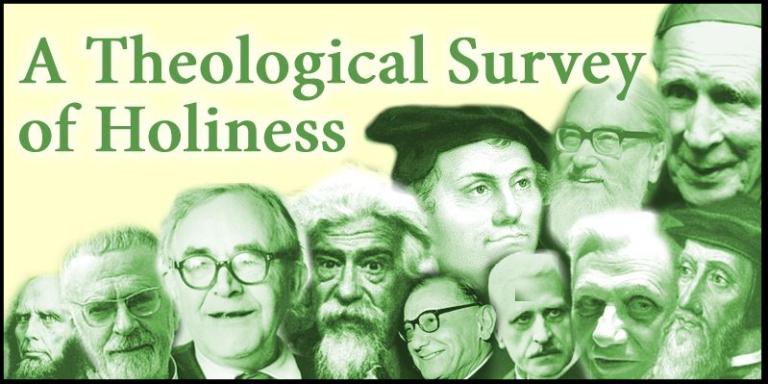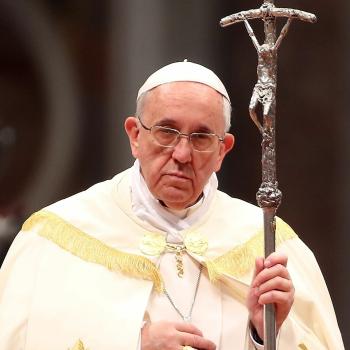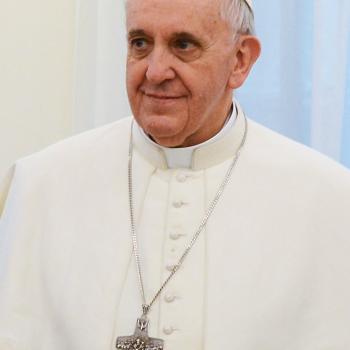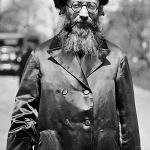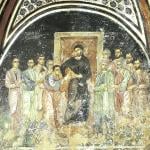I recently posted an article talking about what the word holiness means. Today I want to explore some of the major theological perspective on how to understand holiness theologically. There are six major traditions that have contributed to understandings on holiness in the contemporary milieu. The following sections will review the lens of the tradition, and present how the contemporary theologians in that tradition articulate holiness . The six major traditions to be examined are: 1) Jewish, 2) Eastern Orthodox, 3) Catholic, 4) Reform 5) Lutheran 6) Methodist/Holiness.
1. Judaism
The Jewish tradition is where the Christian concept of holiness is rooted. It is therefore important to examine how the Jewish people understand holiness as a notion. The Mishna, a collection of early authoritative Jewish writings that form the foundation of the Talmud, speak of Holiness as a manifestation of concentric rings spreading out from the temple until they fill the whole world. The center of holiness is the place where God is present in the liturgical life of the community. The closer a place is to God’s liturgical center, the more holy that place is considered.[1]
This concept seems to have had a significant impact on the theological imaginations of the Jewish community throughout the centuries. After the fall of Jerusalem the Jewish community had to reimagine how this “temple centered” holiness could be participated in, without the existence of a temple. A solution was found by looking toward the scriptures. If the temple was God’s holiness in time and space; the scriptures became God’s holiness in words. In recent years this perspective has been particularly influential in the writings of Abraham Joshua Heshel.
Abraham Joshua Heshel
Abraham Joshua Heschel wrote about how words can connect people to the ways God is present in prayers and scripture. This is done through a critical empathy. He expresses the idea of God’s holiness communicated in the scriptures perfectly in his book God in Search of Man. He writes:
“The Bible is holiness in words… It is as if God took these Hebrew words and breathed into them of His power, and the words became a live wire charged with His spirit. To this very day they are hyphens between heaven and earth.”[2]
For Heshel, God makes contact with humanity in his holiness through concrete means. This can take the form of words; it can also take the form of rituals. As people participate in the religious life of their community, a bridge between heaven and earth is established. That bridge does not only remain intact in the context of the worship experience itself, but it also pours into the broader life of the participants in the life of the community. People become transformed by their encounter with holiness, and become holy themselves.[3]
2. The Eastern Orthodox Tradition
The Eastern Orthodox tradition offers a rich heritage of theological reflections on holiness. They draw primarily from scripture, the canons of the first seven ecumenical councils, the writings of the church fathers, and the liturgical life of the community. This focus on the liturgy is particularly important in contextualizing the Eastern Orthodox theological perspective on holiness. Much like the Jewish tradition, the Orthodox tradition links holiness with worship. The liturgical life is the center of the Church’s holiness and that holiness is rooted in the working of the Holy Spirit.
Nearly every Orthodox service begins with a prayer directed toward the Holy Spirit. This prayer asks that the Holy Spirit might be present and that he might cleanse those who participate. Just as the sacrifice in the temple was to be clean so that it might be a holy participant in the temple cult of Israel, so too the people must be cleansed so that they might be holy participants. This starting point is the first of many convictions about the spirit that can be seen in Orthodox worship.
A second feature of Orthodox liturgical life is the Trisagion. This hymn repeats the prayer, “holy God, holy mighty, holy immortal, have mercy upon us.” It is a prayer that has made it into the Western tradition in the Catholic Good Friday service, but is a central prayer in the Byzantine liturgical tradition. It grounds the life of the service in recognition that they are directed toward and present with a God who is essentially holy.[4]
A third element of Orthodox liturgical life is part of the anaphora (the Eucharistic prayer). The Eastern Orthodox liturgy has included from much of it’s like a prayer for the Holy Spirit to come upon the gifts. Witnessed in the liturgy since the time of Cyril of Jerusalem, this prayer has become a central element of Orthodox liturgy.[5]
A final element of Orthodox faith that has contributed to their understanding of what is mean to be holy is the theology of Theosis. Theosis, sometimes referred to as divinization, is the conviction that Christians are transformed by the Holy Spirit to become actual participants in the divine life
These insights have been central in the development of contemporary Orthodox theology. Writers, like Alexander Schmemann, Kallistos Ware and John Meyendorff, have all looked to the tradition of the Church as the source for primary theology for the Church. Their insights on holiness continue to enrich discussion about this issue today.
Alexander Schmemann
Alexander Schmemann was particularly influenced by what he believed the liturgical life of the Church could teach theologians about who God was. He saw the Trisagion hymn as a pivotal moment in the communities encounter with God. He believed it both revealed the otherness of God, as well as articulated the desire of the community. He states:
[The Trisagion] gives God His real Name, and worships His real, heavenly essence, because “holiness” means, on the one hand, that God is the Absolutely Other, and, on the other hand, that He is the desire of all our desire, the goal and fulfillment of our life.[6]
Schmemann saw this prayer as orienting the Church toward the holiness of God both in their attention, but also in their very nature.
Kallistos Ware
Kallistos Ware has spent much of his career delving deep into the contemplative tradition of the Church fathers. He has been able to articulate this wisdom for many contemporary readers, particularly their understanding of theosis. In his seminal book The Orthodox Way, Ware writes “In the age to come God is ‘all in all,’ but Peter is Peter and Paul is Paul.”[7] He underscores that holiness is the calling out of an individual from their sinfulness, into the true selves that God intends for them to be as they participate fully in their eschatological destination: God’s own self.
John Meyendorff
John Myendorff distinguishes the Eastern Orthodox perspective on Holiness by differentiating it from programs of legalism or moralism, which he associates with Western forms of Christian spirituality. Myendorff argues that the focus of the Christian life should be on the personal encounter of the Holy Spirit, through which life growth and transformation are the outgrowth of participation with the Holy Paraclete.[8] He also emphasizes that holiness is a mark of the Church which is always actualized locally. Holiness is not a concept which is disembodied or philosophical but is always associated with a real experience of God.[9]
3. The Catholic Tradition
As the largest Christian tradition, the Catholic Church has arguably contributed the greatest number of voices on this issue over the course of its history. This diverse set of perspectives on holiness has been noted even by outside observers. Take Barry Callen’s evaluation, which states:
“Almost every manifestation of Catholicism emphasized holiness in its many expressions. Franciscans and Dominicans emphasize holiness through mendicant vows; Carmelites emphasize holiness through contemplative prayer; Jesuits emphasize holiness through missionary and educational work; Marionites emphasize holiness by emulating Mary; and so on.”[10]
This diversity means that there is no single way to approach teaching holiness in the Catholic perspective. It also means that there are still many live discussions about the role of holiness in the life and teaching of the Church. Below are highlighted some contemporary voices who are influencing discussion today.
Jean Daniélou
The Twentieth Century Jesuit theologian, Jean Daniélou helped think about the Catholic theology of holiness with an approach that married contemporary concerns with a patristic foundation. He asserted that the encounter with God’s holiness formed a dialectic of the individuals relationship to holiness. People are at first apt to flee from the holiness of God, seeing themselves as lacking. This initial fear, however, is tempered with an innate thirst for purification. He claims that “the soul cannot fail to love the awesome holiness of God.” He roots this contradiction as the heart of “genuine religion.”[11]
Henri de Lubac
Henri de Lubac was one of the Twentieth Century’s foremost theologians on the doctrine of the Church. He believed that holiness was essential rooted in participation in an ecclesiological selflessness which is subjectively expressed in the holiness of Mary and objectively in the ministry of the word and sacraments of the Church in revealing God’s reorientation toward holiness in Christ.[12] Christians best encounter holiness though participating in the liturgical life of the Church and through seeking the grace to emulate the humility and love of the blessed virgin.
Joseph Ratzinger // Pope Benedict XVI
Joseph Ratzinger, the current Pope Emeritus Benedict XVI, spent much of his career living in the tension of a Church that is called holy, and yet is often filled with sinners. He highlights this tension in his formative Introduction to Christianity, stating:
The Church is not called holy in the Creed because its members collectively and individually are holy, sinless man. This dream, which appears afresh in every century, has no place in the world of our text.[13]
Ratzinger argues that the holiness of the Church is rooted in its sanctifying power, which is gifted to it by God’s Holy Spirit. The Church is Holy, because it is God’s instrument of holiness in a world of sinners.
Louis Bouyer
In Louis Boyer’s lecture series-turned book, Liturgical Piety, he explores holiness through the lens of sacrifice. He notes that the root of the word sacrifice comes from the Latin words sacrum and facere, literally meaning to “make holy.” Christ’s sacrifice makes holy a people, the Church, which is a “redeemed city” which, being sanctified by the spirit, offers itself to its redeemer and is offered in-turn to the Father by Christ.[14]
4. Traditions within the Protestant Experience
The protestant reformation was deeply interested in how the concept of holiness related to the life of the Church, the people of God, and God’s plan for the world. Although there are tens of thousands of protestant sects, these sects can be roughly grouped into broad families. When articulating “holiness” as a theological concept there are three primary protestant schools of thought which root the theological assumptions: 1) Lutheranism, 2) Reform/Calvinism, 3) Methodist/ Holiness.
a) Lutheranism
As Lutheranism’s name indicates, the Lutheran tradition is rooted in the theology of Martin Luther. Luther was a steadfast believer that holiness is something offered for people by God’s free gift. Luther, trained as an Augustinian monk, believed that it was the sacramental grace of God through faith alone.[15] It carries on the tradition of the Catholic theologian Erasmus who taught at the time that the three vows of chastity, poverty and obedience produce no greater holiness than that which baptism gives to all Christians.[16] This tradition highlights first and foremost that holiness is divine in origin and believe that if can only be given to people through the action of God. A church or individual, who is made holy, only becomes so through the Gospel of God’s saving work in Jesus Christ. Human effort should not be emphasized in this system, but rather the preaching of God’s gracious gift of holiness gifted through the word and the sacrament.
Rudolf Otto
One of the most influential theologians within the Lutheran tradition to write about Holiness in the past hundred years is Rudolf Otto. His book The Idea of the Holy remains an influential perspective on holiness. He roots his standpoint in a formulation of holiness as concept of the holy as that which is “numinous.” The numinous is that which is beyond the rational or empirical experience of humanity and yet points to some power outside of one’s self. It is a mystery in the sense that it is ungraspable by reason, but not in the way that is unknowable – on the contrary humanity is ontologically in relationship with this holiness and experiences it in a tension of terror and fascination. The experience of the holy, therefore is at one time revelatory but at the same time always conceals. Otto believes that this experience of the holy/numinous is expressed in many aspect of human life, but particularly looks to the liturgical life of the Church as a means. [17]
b) Reform/Calvinism
The reform tradition is rooted in the movement started first by Zwingli and was carried on primarily through a later movement sustained by John Calvin. Unlike the Lutherans, Reform theology has never had a single universal set of confessions that define their doctrine, so identifying exactly what Reform Theology is can be somewhat problematic. However, in spite of this, there are some unifying characteristics to the Reform tradition’s perspective on holiness.
Like Lutheran’s, the Reform tradition emphasizes that it is God who makes something Holy, and thus they emphasis the sovereignty of God. God elects those who will be made holy, and accomplishes it through his grace completely apart from the subjects he elects. This top down approach also manifested in early reform communities. Both Calvin and Zwingli oriented their reforms around communities which were governed by regulations geared on making the behaviors of members of their community more in line with their perspectives on holy living.
The reform perspective offers two goals to Holiness. The first goal is the glory of God, which is the teleological end of the reform theological system. As Christ’s Church is made holy, through the sanctifying work of the Holy Spirit, God is glorified. There is nothing in history, in this perspective, which will honor God in history as much as the Holiness of his Church. The second goal of holiness is more proximate. It seeks that the lives of the individual members of the Christian community would become more and more free from sin, and conformed to the will of God. This is a good within itself.[18]
Karl Barth
Arguably the most influential reform theologian in the past 100 years, Karl Barth highlighted that holiness, although mentioned as a mark of the Church in the Creed, is not something that an individual believes in, but rather that through a the belief in the Holy Spirit the faithful know the Church’s holiness. This is not a holiness the church owns but it is the holiness of Christ. Therefore the Church receives its holiness passively, and from that passive receptivity responds actively into that reality.[19]
c) Methodist/ Holiness
The branch of the Christian tree most closely associated with the idea of holiness is the Methodist branch. This group of Christians was even called the “holy club” in its earliest days. This theme of holiness has stayed a central component to much of the thinking within Methodism, as well as in the branches that have grown from it. It was started by the Anglican priest, John Wesley.
As part of the Methodist system was the doctrine of Christian Perfection. This is a belief that individuals can achieve a state of sinlessness in their own lives. This life of personal sinlessness is only accomplished through God’s grace and is understood as holiness. John Wesley focused on holiness as being a state which “enables us to present out souls and bodies… as a sacrifice to God.”[20] It is only accomplished when the “power of God overshadows us and we are brought from darkness to light.”[21] Wesley considered this transformation, by the Holy Spirit, to be an essential element for the eternal salvation of an individual. There had previously been some discussion within the Catholic Church about this theology, primarily in the writings of Dun Scotus and Thomas Aquinas. In the reformation the idea had been flatly rejected by Martin Luther. John Wesley revived this theological perspective. This element of Wesleyan thought became the cornerstone of a movement that emerged in the 19th century, the Holiness Movement.
Holiness Movement
The holiness movement was focused on restoring a theology of perfection that they had become convinced was lost. Primarily an American movement, it focused on a belief that there was a second blessing of perfection in love which was distinct from Christian regeneration. It was primarily promoted by Phoebe Palmer, and later through a similar teaching promoted by Charles G. Finney. This movement focuses on the visible elements of holiness in a person’s life. Holiness is considered a gift of God, but it is a gift which is fully actualized during an individual’s lifetime. They argue that people can achieve a state where they are no longer even tempted to sin.[22]
Notes
[1] Marcus Borg, Conflict, Holiness, and Politics in the Teachings of Jesus, Revised Edition (Harrisburg, PA: Bloomsbury T&T Clark, 1998), 75.
[2] Abraham Joshua Heschel, God in Search of Man: A Philosophy of Judaism (New York: Macmillan, 1976), 244.
[3] Edward K. Kaplan, Holiness in Words: Abraham Joshua Heschel’s Poetics of Piety (West Fulton, NY: SUNY Press, 1996), 80.
[4] Hugh Whybrew, The Orthodox Liturgy (London: SPCK, 1989), 6.
[5] Ibid., 35.
[6] Alexander Schmemann, Liturgy and Tradition: Theological Reflections of Alexander Schmemann, ed. Thomas Fisch (Crestwood, NY: St Vladimirs Seminary Press, 1990), 107.
[7] Kallistos T. Ware, The Orthodox Way (Yonkers, NY: St Vladimir’s Seminary Press, 1995), 168.
[8] John Meyendorff, Byzantine Theology: Historical Trends and Doctrinal Themes (New York: Fordham University Press, 1979), 176–77.
[9]Ibid., 209.
[10] Barry Callen, “The Context: Past and Present,” in The Holiness Manifesto, ed. Kevin W. Mannoia and Don Thorsen (Grand Rapids, Mich.: William B. Eerdmans Publishing Company, 2008), 11.
[11] Jean Danielou, God and the Ways of Knowing, trans. Walter Robert (San Francisco, CA: Ignatius Press, 2003), 117.
[12] Henri de Lubac, La Foi Chrétienne (Paris: Aubier Montaigne, 1969), 295–310.
[13]Joseph Ratzinger, Introduction to Christianity (Revised Edition), ed. J. R.Translator Foster (Ignatius Press, 2004), 263.
[14] Louis Bouyer, Liturgical Piety (Notre Dame, IN: University of Notre Dame, 1955), 160.
[15] This Augustinian heritage is particularly important because of the way that Augustine’s theology of sanctification emerged. He spent much of his career fighting with the Donatist (who believed God’s sacramental work was contingent on the holiness of the officiant) as well as the Pelagians who believed that salvation was something that a human could achieve through their own holiness. Luther, therefore, was forged in the theological tradition that most emphasized God’s essential role and power in salvation and sanctity.
[16]Erasmus, Enchiridion Militis Christiani, trans. V Welzig, Erasmus von Rotterdam, Ausgewählte Schriften 1 (Darmstadt, 1968), 48f. Quoted in: Heiko Augustinus Oberman, The Reformation : Roots and Ramifications (London ; New York: T&T Clark, 2004), 71.
[17] Rudolf Otto, The Idea of the Holy, trans. John W. Harvey, 2 edition (New York: Oxford University Press, 1958), 65.
[18] For a contemporary articulation of the Reform perspective on sanctification see: Anthony A. Hoekema, “The Reformed Perspective,” in Five Views on Sanctification (Grand Rapids, Mich.: Zondervan, 1996), 59–90.
[19] Karl Barth, The Doctrine of Reconciliation, ed. T. F. Torrance, trans. G. W. Bromiley, vol. 4.1, Church Dogmatics (Edinburgh: Bloomsbury T&T Clark, 1956), 685–700.
[20]John Wesley, The Holy Spirit and Power (Alachua, FL: Bridge Logos, 2003), 68.
[21]Ibid.
[22] For a full history of the movement see: M. E. Dieter, The Holiness Revival of the Nineteenth Century (Lanham, Md, 1996).


